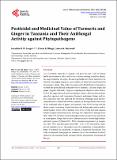Pesticidal and Medicinal Value of Turmeric and Ginger in Tanzania and Their Antifungal Activity against Phytopathogens

View/
Date
2025-02-20Author
Lengai, Geraldin
Mbega, Ernest
Muthomi, James
Metadata
Show full item recordAbstract
Use of synthetic pesticides to manage crop pests has had a toll on human
health, environmental safety and farmer’s income creating a need for alterna
tive crop protection strategies. Botanical pesticides have been reported to be
effective in managing crop pests, and a number of them have been formulated
and commercialized. This study was conducted in North-Eastern Tanzania to
establish the pesticidal and medicinal value of turmeric (Curcuma longa) and
ginger (Zingiber officinale). Purposive sampling was adopted to select and in
terview 167 respondents drawn from farmers, traders, pharmaceutical shops,
agro-shop operators and consumers of turmeric and ginger. Ginger and tur
meric rhizomes were also collected for extraction, antifungal assay and bio
chemical analysis. Results showed that majority of the respondents were aware
of the medicinal value of ginger and turmeric, with 59.5% having used the
plants to treat respiratory related infections and healing skin surface and in
ternal wounds. About 14% of farmers were aware of and had used aqueous
botanical preparations from neem, moringa and Tephrosia to manage insect
pests. Only 2.7% of farmers had used ginger powder as a protective insecticide
on stored grains. Ginger and turmeric rhizome extracts showed high antifun
gal activity against Pythium (83% - 95%), Fusarium oxysporum f. sp. lycoper
sici (34% - 52%) and Alternaria solani (38% - 53%). A GC-MS analysis of gin
ger and turmeric extracts showed presence of α-zingiberene, β-sesquiphellan
drene, α-farnesene, ar-curcumene, α-copaene, ar-tumerone and curlone. This
study recommends that ginger and turmeric extracts be considered for devel
opment of a botanical pesticide and especially for management of damping off
diseases.
